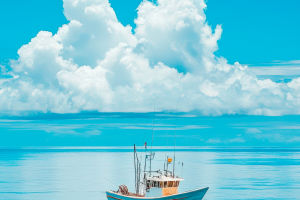The vast ocean holds abundant oil resources, and offshore drilling platforms are key tools in harnessing these resources.
These platforms rise above rough seas, housing drilling equipment, mining machinery, and living spaces for workers.
Since their inception, offshore drilling platforms have undergone numerous technological innovations and developments. From the earliest barge-type platforms to today's advanced semi-submersible and tension-leg platforms, humans have continuously overcome challenges to extract valuable energy from deep-sea environments more efficiently and stably.
The first offshore drilling platform, the barge-type platform, was introduced in 1937. Its design was relatively simple: it relied on the hull sinking to the seabed for stability. After completing its drilling operations, the platform would float back to the surface and move to the next drilling site.
However, barge-type platforms could only operate in shallow waters and were unsuitable for deep-sea drilling. As the need for deeper ocean drilling grew, engineers began developing platforms capable of operating in deeper waters.
Among these early innovations was the sinking and floating platform. Supported by columns, this platform could operate at water depths ranging from a few meters to tens of meters, offering greater flexibility than the barge-type platform.
As technology advanced, floating drilling platforms emerged as a significant breakthrough in offshore drilling. These platforms float entirely on the sea’s surface, held in place by either giant anchors or dynamic positioning systems.
However, one of the main challenges with floating platforms is their limited ability to resist wind and waves. The constantly changing offshore climate, along with fierce winds and waves, often forces floating platforms to suspend operations. This limitation led engineers to seek more stable solutions.
The development of fixed drilling platforms addressed the stability issue. In 1947, the first steel jacket fixed platform was constructed in the Gulf of Mexico. Unlike floating platforms, fixed platforms offer exceptional stability.
They are securely anchored to the seabed, making them highly resistant to wind and wave impacts. However, fixed platforms have their own set of drawbacks: they are costly to construct and, once built, cannot be easily moved.
Although they have a long service life, their lack of flexibility makes them ill-suited for exploration in multiple locations. Furthermore, as drilling depths increase, the cost and material consumption of fixed platforms rise exponentially. This limitation forced engineers to search for more economical and flexible solutions.
Semi-submersible drilling platforms were developed to meet these challenges. These platforms are supported on the surface by columns, with large pontoons submerged in the sea to maintain stability. The pontoons control the platform’s buoyancy by adjusting the volume of seawater inside them.
This design allows semi-submersible platforms to withstand strong winds and high waves effectively. Since the pontoons are positioned deep in the water, they experience less wave impact, while the columns can withstand the strong forces near the surface.
As a result, semi-submersible platforms exhibit excellent stability, capable of operating in wind speeds above 12 on the Beaufort scale and waves as high as 20 to 30 meters.
The success of semi-submersible platforms paved the way for further advancements in offshore drilling technology, leading to the development of tension-leg platforms. These platforms are based on semi-submersible designs but incorporate a tension-leg structure.
Steel tendons anchor the platform to the seabed, significantly improving its stability and reducing the platform’s drift in ocean currents. This feature is particularly advantageous in deep-sea environments, where tension-leg platforms have demonstrated remarkable performance.
Capable of drilling in waters nearly 1,000 meters deep, the tension-leg platform represents one of the most advanced offshore drilling technologies.
The continuous innovation of offshore drilling platforms has driven progress in global energy development. Faced with the challenges of complex marine environments and the increasing demand for energy, designers and engineers of drilling platforms continue to push the boundaries of technology.
Their efforts aim to make platforms more efficient, stable, and safe. The advent of semi-submersible and tension-leg platforms allows humans to safely exploit oil resources in deeper waters. This represents not only a leap in technology but also humanity’s growing mastery over natural resources.
Looking ahead, the development of offshore drilling platforms will likely focus on sustainability as new energy technologies advance and environmental awareness increases. The design and operation of these platforms will need to balance energy supply with minimizing environmental impact.
This shift toward sustainability marks a new direction in marine energy development. The technological advancements in offshore drilling platforms have not only propelled the oil industry forward but also opened up broader prospects for the sustainable exploration and utilization of marine resources.


